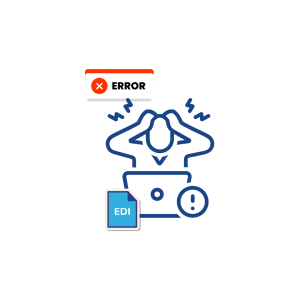Introduction to EDI Security
Since 1975, corporations of all sizes have put their trust in Electronic Data Interchange (EDI) to exchange commercial transactions with their trading partner community, and since 1984, they have relied and put their trust in Value Added Networks (VANs) to move these transactions in a Store & Forward model for data handling.
Commport entered the EDI Services industry, became a VAN in 1985, and built a reputation for service and customer support based upon adding to and justifying this trust.
When a company hires Commport as its VAN provider, that company trusts that its data will be safe from loss and kept confidential between them and the trading partner and that the Commport EDI VAN will manage this delivery request and any returned transactions. The ability to maintain the trust of the Commport VAN or VANs involved depends upon the security of these deliveries – they went where they were supposed to go and nowhere else.
That is why Commport has developed all the internal processes involved in handling customer data in-house to ensure at every step that the data is correctly formatted, routed, and delivered to the destination. If an issue is found, the application involved immediately alerts support, and the issue is addressed within minutes. For over 40+ years, Commport has ensured that retailers and their vendors or customers get the correct data. We are also SOC II Type II certified.
The Challenges Associated with EDI Data Security
1. Understanding the Risks
Before delving into the security measures, it’s essential to understand the potential risks associated with EDI data. Some common vulnerabilities include:
a) Unauthorized Access: The sensitive nature of EDI data makes it an attractive target for cybercriminals seeking to gain unauthorized access and exploit it for their gain.
b) Data Integrity: Ensuring that the data exchanged through EDI remains intact and unaltered during transmission is crucial. Tampering with data can lead to serious financial and reputational consequences.
c) Interception: EDI data is transmitted over various networks, which increases the risk of interception. Malicious actors can intercept data packets and extract valuable information.
2. Implementing Strong Authentication
To mitigate the risks of unauthorized access, robust authentication mechanisms are essential. Implementing strong password policies, multi-factor authentication (MFA), and encryption techniques can significantly enhance the security of your EDI system. Additionally, consider utilizing secure protocols such as Secure File Transfer Protocol (SFTP) or secure AS2 connections for transmitting EDI data.
3. Encryption and Data Integrity
Encrypting EDI data both at rest and in transit provides an additional layer of security. Encryption ensures that even if the data is intercepted, it remains unreadable and unusable to unauthorized parties. Additionally, implementing data integrity checks, such as digital signatures or checksums, allows you to verify the integrity of data upon receipt, minimizing the risk of tampering.
4. Network Security
Securing the network infrastructure is crucial to safeguard EDI data. This includes implementing firewalls, and intrusion detection systems (IDS), and regularly patching and updating network devices. Segregating the EDI system from other networks and applying the principle of least privilege to limit access can further minimize the risk of unauthorized access.
5. Regular Auditing and Monitoring
Implementing robust monitoring and auditing mechanisms helps detect any suspicious activities or breaches promptly. Monitoring user access logs, network traffic, and system logs can provide valuable insights into potential security incidents. Regularly reviewing and analyzing these logs can help identify vulnerabilities and ensure timely response and mitigation.
6. Partner and Vendor Management
When engaging in EDI with external partners or vendors, it’s essential to assess their security practices. Evaluate their security protocols, encryption methods, and authentication mechanisms. Establish clear security agreements and conduct regular audits to ensure compliance with agreed-upon security standards.
7. Employee Training and Awareness
Human error remains a significant contributor to data breaches. Educating employees about the importance of data security, raising awareness about common phishing techniques, and providing regular training on best practices can go a long way in preventing security incidents. Encourage employees to use strong passwords, be vigilant about suspicious emails, and report any potential security threats promptly.
Commport's Take On EDI Security
At Commport, the security of our clients’ data is our top priority. We are committed to implementing robust security measures to protect sensitive information, ensuring that our solutions not only meet but exceed industry standards. We adhere to the most stringent security protocols and best practices, continuously evolving our strategies to stay ahead of potential threats. Commport is proud to be SOC II Type II certified. Request your copy today
Conclusion
EDI data security is a critical aspect of maintaining the confidentiality, integrity, and availability of your business’s sensitive information. By implementing a comprehensive security strategy that includes strong authentication, encryption, network security measures, and regular monitoring, you can protect your EDI data and instill confidence in your customers. Stay informed about the latest security practices and adapt your security measures accordingly to stay one step ahead of potential threats.
Want to know more aboiut Commport EDI and VAN Services?
Download: EDI Buyers Guide
Unlock the full potential of your supply chain with our comprehensive EDI Buyer's Guide — your first step towards seamless, efficient, and error-free transactions
Frequently Asked Questions
The transmission of EDI data is secure, as it often employs encryption protocols such as AS2 or secure sFTP. These methods ensure that the data is protected during transmission, safeguarding it from unauthorized access or interception.
Authentication is a critical component of EDI security. It verifies the identities of parties involved in the data exchange, preventing unauthorized access. Secure methods, such as usernames, passwords, and digital certificates, are commonly used to authenticate users and ensure the integrity of the data.
Data integrity is maintained through various measures, including checksums and digital signatures. These techniques help detect any alterations or tampering during the transmission process, ensuring that the received data is identical to the original, thus maintaining the integrity of the information.
Yes, there are industry-specific compliance standards for EDI security, such as HIPAA for healthcare or GDPR for data protection. Businesses ensure adherence by implementing secure EDI solutions that comply with these standards and regularly updating their security measures to meet evolving requirements.
Businesses can protect stored EDI data by implementing robust cybersecurity measures. This includes using firewalls, regularly updating security software, restricting access to authorized personnel, and conducting routine security audits. Additionally, educating employees on best practices for data security is crucial in preventing internal threats.






